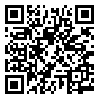Volume 7, Issue 14 (12-2017)
JRSM 2017, 7(14): 1-14 |
Back to browse issues page
Download citation:
BibTeX | RIS | EndNote | Medlars | ProCite | Reference Manager | RefWorks
Send citation to:



BibTeX | RIS | EndNote | Medlars | ProCite | Reference Manager | RefWorks
Send citation to:
Hemmati Nezhad M A, Masoomi H. The Relationship between Brand Personality dimensions and Consumer’s Loyalty to Sports Brands in Rasht city. JRSM 2017; 7 (14) :1-14
URL: http://jrsm.khu.ac.ir/article-1-2654-en.html
URL: http://jrsm.khu.ac.ir/article-1-2654-en.html
Abstract: (8692 Views)
The purpose of the present study was to explain the relationship between brand personality dimensions and customers’ loyalty to sport brands in Rasht. The method of present survey was descriptive and applied, also the statistical population was loyal customers to sport brands in Rasht. In order to data collection two questionnaires; Geuens & Wulf (2009) for measuring brand personality dimensions and Lau et all (2006) that investigated customers loyalty to sportswear in Hong Kong, after determining the validity and reliability was confirmed by using Cronbach’s alpha (0.7); were used. The results of Linear Regression of 407 loyal customers were shown there were positive and negative significant relationships between brand personality dimensions (Activity, Aggressiveness, Responsibility, Emotionality and Simplicity) and customers loyalty components to sport brands (Brand name, Service quality, Store environment, Product quality, Promotion, Price and Style). Some of these results are as below: activity dimension and brand name factor; activity and aggressiveness dimensions and service quality factor; activity, simplicity and responsibility dimensions and store environment factor; activity, aggressiveness and responsibility dimensions and product quality factor. There were also some negative ones between simplicity dimension and product quality and style factors. The result of Friedman test revealed that product quality, style, brand name, promotion, price, store environment and service quality were the most fundamental and crucial factors for the customers’ loyalty respectively. Regarding to the findings attention to customers’ demands and needs significantly has effect on performance improvement and local produced Sport brand’s success to attracting the customers and making them loyal in order to achieving more market share in comparison with competitors in international markets.
Type of Study: Research |
Subject:
sport management
Received: 2014/06/13 | Accepted: 2014/06/16 | Published: 2018/02/7
Received: 2014/06/13 | Accepted: 2014/06/16 | Published: 2018/02/7
References
1. 1. Ang S.H & Lim E, (2006). The Influence of Metaphors and product type on brand personality perceptions and attitudes. Journal of advertising, 35, 2, ABI/inform global.
2. 2. Lin L.Y, (2010), The relationship of consumer personality trait, brand personality and brand loyalty: an empirical study of toys and video games buyers, Journal of Product & Brand Management, 4–17.
3. 4. Gill M & Dawra J, (2010). Evaluating Aaker’s sources of brand equity and the mediating role of brand image. Journal of Targeting, Measurement and Analysis for Marketing Vol. 18, 3/4, 189–198.
4. 5. Aaker DA. (1991), Managing brand equity. The free press.
5. 6. Avis M, (2009), the Problems of Brand Definition, ANZMAC, 1-10.
6. 7. Calavova E, Petrackova J, (2011), The Brand Personality of Large Sport Events, Kinesiology 43, 91-106.
7. 11. Aaker J.L, (1997), Dimensions of Brand Personality. Journal of Marketing Research Vol. XXXIV, 347-356.
8. 12. Smith A.C.T., Graetz B.R & Westerbeek H.M. (2006), Brand personality in a membership-based organization. Int. J. Nonprofit Volunt. Sect. Mark. 11: 251–266.
9. 13. Carlson B.D, Donavan D.T & Cumiskey K.J, (2009), Consumer-Brand Relationships in Sport: Brand Personality and Identification, International Journal of Retail & Distribution Management, Vol. 37 No. 4, 370- 384.
10. 14. Grohmann B, (2009), Gender Dimensions of Brand Personality. Journal of Marketing Research 105 Vol. XLVI, 105–119.
11. 15. Braunstein J.R & Ross S.D, (2010), Brand Personality in Sport: Dimension Analysis and General Scale Development, Sport Marketing Quarterly, 19, 8-16.
12. 18. Geuens, M., Weijters, B., & Wulf, K. D. (2009). A New Measure of Brand Personality. Intern. J. of Research in Marketing, 26, 97-107.
13. 19. Lau M, Chang M, Moon K & Liu W, (2006), The Brand Loyalty of Sportswear in Hong Kong, JTATM, Volume 5, Issue 1, 1-13.
14. 21. Kim Ch, Han D, Park S.P, (2001), The effect of brand personality and brand identification on brand loyalty: Applying the theory of social identification, Japanese Psychological Research Invited Paper, Volume 43, No. 4, 195–206.
15. 22. Bauer, H., Sauer, N., Exler, S. (2005), The Loyalty of German Soccer Fans: Does a Team’s Brand Image Matter?,International Journal of Sports Marketing & Sponsorship, 14-22.
16. 23. Mengxia Z, (2007), Impact of Brand Personality on PALI: A Comparative Research between Two Different Brands, International Management Review Vol. 3 No. 3, 36-44.
17. 26. Lee S, Shin H, Park J, Kwon O, (2010), A Brand Loyalty Model Utilitizing Team Identification and Customer Satisfaction in the Licensed Sports Product Industry, Journal of Research, volume 5, issue 1, 60-67.
18. 32. Tsai M, Tsai Ch & Chang H, (2010), The Effect of Customer Value, Customer Satisfaction and Switchig Costs onCustomer Loyalty: An Empirical Study of Hypermarkets in Taiwan, Social Behavior and Personality, 38(6), 729-740.
19. 33. Bee C, Havitz M, (2010), Exploring the relationship between involvement, fan attraction, psychological commitment and behavioural loyalty in a sports spectator context, International Journal of Sports Marketing & Sponsorship, 140-157.
| Rights and permissions | |
 | This work is licensed under a Creative Commons Attribution-NonCommercial 4.0 International License. |





